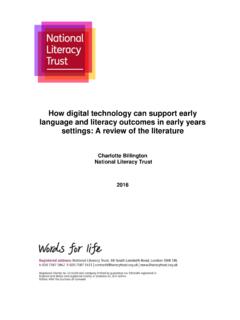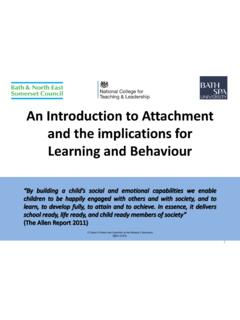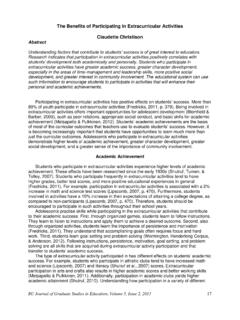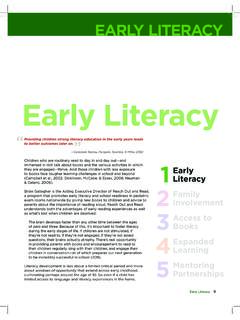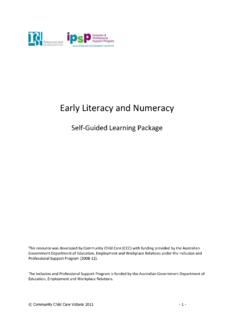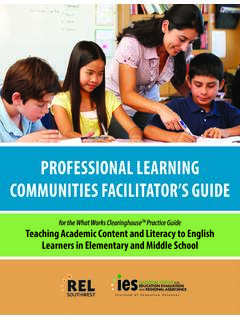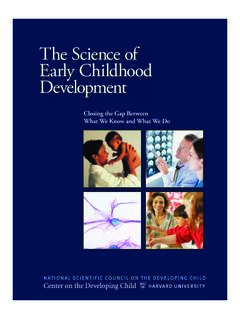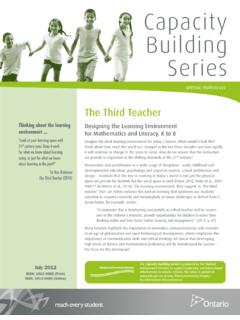Transcription of Developing Literacy Through Play
1 Journal of Inquiry & Action in Education, 3(1), 2009 15 | Page Developing Literacy Through Play Alissa Marie Mielonen Buffalo State College Wendy Paterson St. John Fisher College Researchers agree that language and Literacy derive from the first days of a child s life. Children become literate members in society by listening and interacting with the people that surround them. This study examines how children develop Literacy Through play by looking closely at the benefits of uninterrupted play and how it encourages language development. The development of language skills, including reading and writing competence, Through social interaction, was observed to see how Literacy development occurs within a home environment. This study also offers successful strategies to use during play that will enhance reading and writing skills within young children. Seven years into the educational milieu created by No Child Left Behind, it is abundantly apparent that opportunities in school for children to develop social skills such as group learning and playing collaboratively together are being replaced by additional time spent on core curriculum activities.
2 As a child interacts with parents, siblings, families and eventually teachers and classmates, these interactions occur primarily Through play. Poor social skills result from limited social interactions which (in theory) interfere with language development. Language and Literacy are built from the first day of a child s life. Literacy can be defined as the ability to interpret and understand messages relayed from others as means to communicate (Tsao, 2008, ). Literacy skills are constructed from the knowledge of spoken language. Through communicating with others, young children develop their own linguistic competence and this allows children to develop their communicative abilities throughout their lives. Linguistic competence will enhance the child s knowledge and facilitate learning and growth. When children play and communicate Through play, they are learning how language works and gaining an understanding of how to interact with other people.
3 Eventually, children connect the meaning of spoken language to written language, which is the key to success in school. This particular phenomenon is important to study because we believe it is crucial to understand how children develop Literacy Through play. Journal of Inquiry & Action in Education, 3(1), 2009 16 | Page Researchers agree that language and Literacy derive from the first days of a child s life. Tsao (2008) believes that a child develops Literacy skills from hearing language spoken around them ( ). Saracho (2002), Meek (1991), and Health (1983), believe that children develop Literacy skills Through different types of settings such as the print they see around them and hearing stories read aloud to them (as cited in Williams & Rask, 2003, ). Saracho and Spodek (2006) state During play children participate in reading and writing experiences that develop the Literacy skills they need for formal reading instruction ( ). The purpose of our study is to examine how children develop Literacy Through play so that we can implement effective play strategies for Literacy learning in classrooms.
4 In particular, we have identified three key questions: 1. What are the benefits of play for language development? 2. How do children develop language skills including reading and writing competence Through social interaction? 3. How can I implement playful social interactions in my Literacy classroom? If we can show how Literacy skills are developed Through play, we can improve the reading and writing competence of students Through playful activities. Through play children may also develop competence in social skills. This study also offers successful strategies to use during play that will enhance reading and writing skills within young children. Theoretical Framework The theorists who have studied the relationships between Literacy development and play include Maria Montessori, Jean Piaget, Lev Vygotsky, and Brian Cambourne. All four theorists suggest that when children interact with the world around them, they are likely to remember first-hand experiences rather than vicarious experiences that are told to them by others.
5 According to these theorists, children learn most by performance, not by prompt. Montessori s theories about children have influenced the way all early childhood programs are structured today (Mooney, 2000, ). Maria Montessori believed in setting up a productive environment where children could develop their Literacy skills without even knowing it. Montessori schools are constructed to suit the needs of young children by providing them with child-size furniture and all materials within their reach. Montessori believed in allowing young children the opportunity to become self-constructivist learners (Mooney, 2000, ). According to Journal of Inquiry & Action in Education, 3(1), 2009 17 | Page Montessori, children learn best by doing, and Through repetition (Mooney, 2000, ). In order to facilitate the development of competence and responsibility, Montessori believed that teachers should include ample amounts of free time for children to structure their own work and play (Mooney, 2000, ).
6 Piaget explained his theory of children s cognitive development Through labeling of age-based stages. Of most relevance to this study young children were thought by Piaget to be engaged in the concrete operational stage of cognitive development. In the stage of concrete operations, children develop reversibility which allows them to retrace the steps of their thinking (Mooney, 2000, ). Once children develop the capability of directing the path of their thoughts, they are able to problem solve on a higher scale. In the concrete operational stage, children also begin to give specific meaning and detail to objects rather than simply naming them. With this reversibility children begin to think abstractly. Piaget s theory suggests that children construct meaning by interacting with their surroundings. The way a child interacts within an environment is what creates learning (Mooney, 2000, ). Furthermore, Piaget believed that children come to understand concepts by engaging in play.
7 Play offers a natural way for children to express ideas. Children learn by watching and imitating situations around them. Piaget believed learning Through trial and error enhances a child s cognitive abilities (Mooney, 2000, ). Cognitive skills that are related to a child s reading and writing abilities may be developed Through make believe (Tsao, 2008, ). Building on Piaget, Roskos and Christie (2004) believe that as children engage in play, they are using their memories to assist to connect their play to pre- Literacy skills such as naming and symbolic thought. Children recall their past play experiences and create new meanings each time they play. (as cited in Tsao, 2008, ). Russian sociologist, Lev Vygotsky first articulated the theory that the world children inhabit is shaped by their families, communities, socioeconomic status, education, and culture (Mooney, 2000, ). He called this social-constructivism. The context and contacts children experience influence how they will interpret the world around them.
8 The ethics and morals instilled in children early in life will affect how they react to situations throughout their lives. Young children also learn from each other. Vygotsky believed children, develop language skills and grasp new concepts as they speak to and listen to each other (Mooney, 2000, ). He explained how children learn when they play: Language and development build on each other. Journal of Inquiry & Action in Education, 3(1), 2009 18 | Page When children play, they constantly use language. They determine the conditions of make-believe. They discuss role and objects and directions. They correct each other. They learn about situations and ideas not yet tried (Mooney, 2000, ). Social interactions involving language that children experience during play helps construct their Literacy knowledge (Tsao, 2008, ). Brian Cambourne developed his theory of The Conditions of Learning as it applies to Literacy learning after he observed children s learning within his own classroom.
9 Cambourne, a seasoned teacher, conducted research in language acquisition and found that children had to construct their own knowledge to deeply learn it. Cambourne created a model that teachers can use to facilitate language learning. The model includes: immersion, demonstration, engagement, expectations, responsibility, approximations, employment, and response. Immersion requires the child to be constantly exposed to language. Language needs to be surrounding the child in all aspects of learning. Demonstration means the child learns by observing a model and then practicing independently. Engagement involves the child s active participation. Expectations should be implemented that are suitable for the particular learner. Expectations are created, but not limited to, goals that the child should reach. Responsibility means that the child must decide for herself/himself what actions s/he will take. Approximations are when the child attempts to apply knowledge to the situation in what is often called trial and error.
10 Employment offers the child opportunity to practice what has been learned and apply knowledge to new situations. Response provides the child with feedback from the facilitator of the language learning (most often an adult). Often children will value feedback from significant adults and seek approval of their language use. These conditions assist teachers in understanding student discovery learning. Cambourne believes that these conditions of learning create an interactive and dynamic experience between the learner and the content (Rushton, Eitelgeorge, and Zickafoose, 2003, ). In play, the conditions of learning are achieved, allowing children to practice and engage in oral language and transfer it to Literacy learning. When children are engaged in play, they must use language in order to communicate and negotiate meaning (Cambourne, 1995, ). Play and Literacy Literacy can be loosely defined as, the ability to read and write (Tsao, 2008, ).











